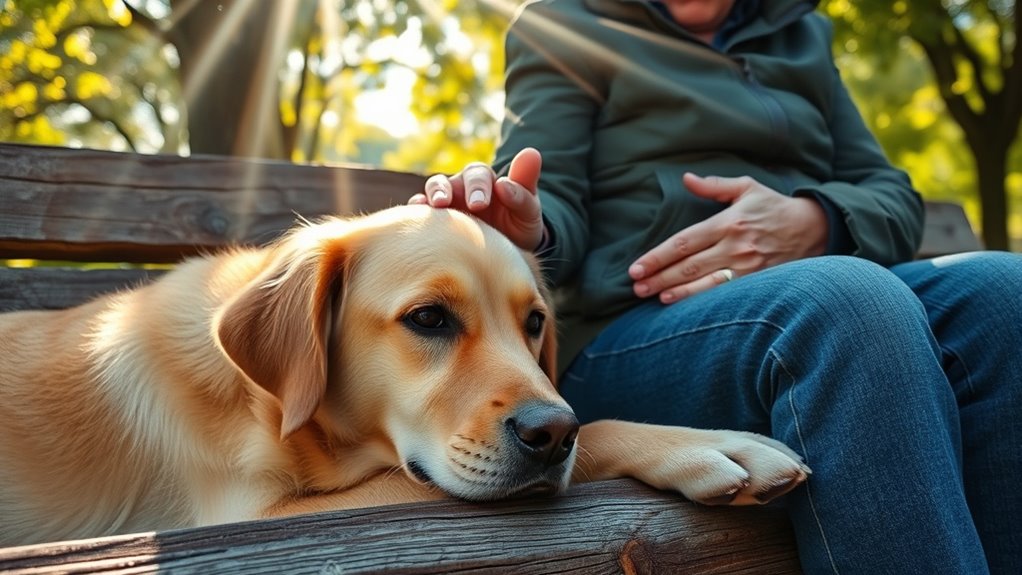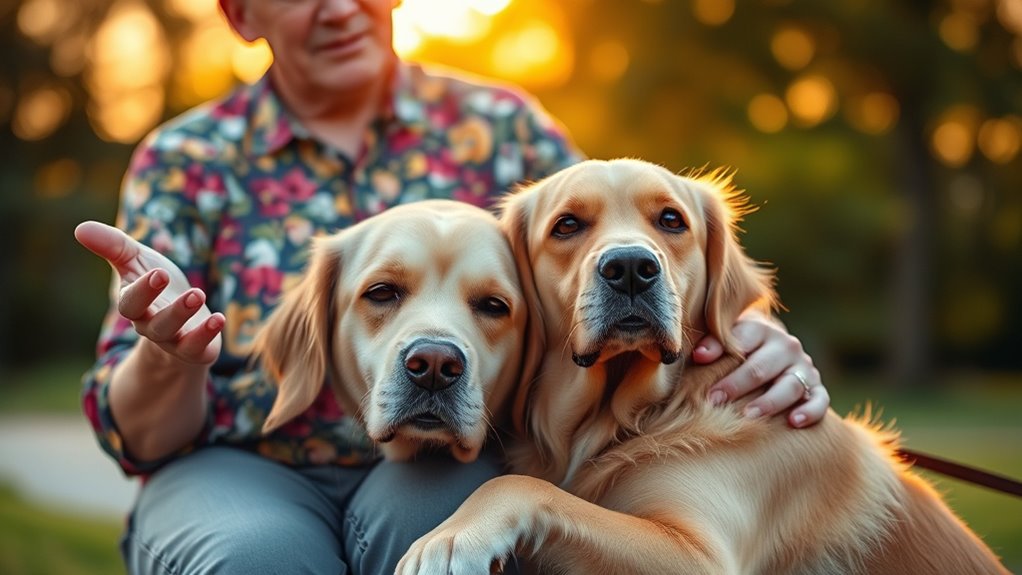Pets form strong bonds with deaf owners by relying on non-verbal cues like gestures, body language, and eye contact. Studies show that dogs, in particular, are quick to pick up on visual signals and respond proactively to instructions without words. They become more observant and empathetic, improving emotional connections. If you want to discover more about how these unique interactions develop, keep exploring the surprising ways pets adapt and communicate beyond speech.
Key Takeaways
- Pets often form strong bonds with deaf owners through non-verbal cues like gestures and eye contact.
- Dogs excel at reading body language and respond well to visual commands from deaf owners.
- Pets become more attentive and empathetic, sensing owners’ emotional states without verbal communication.
- Studies show animals adapt to unique visual and physical signals used by deaf owners, strengthening trust.
- Shared unspoken communication fosters deeper emotional connections and enhances mutual understanding.

Many pets can adapt remarkably well to deaf owners, often forming strong bonds despite communication barriers. While it might seem challenging at first, animals are incredibly perceptive and can pick up on subtle signals that go beyond spoken words. As a deaf owner, you learn to rely on different communication cues such as gestures, body language, and facial expressions. These cues often become just as meaningful, if not more so, than verbal commands. Your pet begins to recognize your unique signals—perhaps a specific hand motion, a nod, or a certain posture—that indicate your needs or emotional state. Over time, these cues strengthen your emotional bond, creating a relationship rooted in trust and understanding.
Dogs, in particular, excel at reading body language and respond to visual cues. They can be trained to notice your gestures and respond accordingly, whether it’s pointing to indicate a direction or raising your hand to signal “sit.” Many owners find that their pets become more attuned to their emotional cues, sensing when they’re upset, anxious, or happy, even without verbal communication. This heightened awareness often deepens the connection, making the relationship more intuitive and empathetic. Your pet learns to interpret your non-verbal signals, fostering a sense of companionship that transcends spoken language.
Research supports this idea, showing that animals can form emotional bonds based on consistent, non-verbal interactions. For example, studies have observed that deaf pet owners often develop a unique rhythm of communication with their animals, relying on touch, eye contact, and movement rather than words. This dynamic encourages pets to become more observant and responsive to emotional cues, reinforcing their attachment to you. It’s a mutual process—your pet’s attentiveness helps you feel understood and supported, which in turn reinforces your emotional connection.
Additionally, visual communication is especially crucial for deaf pet owners, as it enables more clear and immediate understanding between you and your animal. Despite the absence of speech, your pet’s ability to respond to your cues illustrates their remarkable adaptability. They thrive on the visual and physical signals you provide, and in doing so, they often develop a deeper, more nuanced awareness of your emotional needs. This kind of communication fosters trust and loyalty, proving that language isn’t the only way to connect. Your bond isn’t just built on commands; it’s shaped by shared understanding, emotional resonance, and the unspoken language that you both create together.
Frequently Asked Questions
How Do Deaf Owners Communicate With Their Pets Daily?
You communicate with your pet daily through visual cues and tactile signals, making your bond strong despite hearing loss. You might use hand signals, eye contact, or body language to give commands or show affection. Tactile signals like gentle taps or petting help reinforce your messages. This consistent non-verbal communication helps your pet understand you clearly, strengthening your connection and ensuring effective interaction every day.
Are Specific Pet Breeds More Responsive to Deaf Owners?
You’re about to discover that certain breeds have a superpower for breed sensitivity and training adaptability, making them more responsive to deaf owners. While no breed is guaranteed to excel, some, like Border Collies or Golden Retrievers, often show greater responsiveness due to their social nature. Your connection depends more on your training approach than breed, so with patience, any breed can thrive in a deaf-owner relationship.
Do Pets Experience Emotional Changes Around Deaf Owners?
You might notice that pets experience emotional recognition and behavioral shifts around deaf owners. They often adapt by relying more on visual cues and body language, which can lead to stronger bonds. These behavioral shifts show your pet’s sensitivity to your emotions, helping them respond appropriately. As a result, your relationship deepens, demonstrating that pets can indeed sense and react to emotional changes, fostering mutual understanding and trust.
Can Deafness Affect a Pet’S Behavior or Training?
Deafness can influence your pet’s behavior and training, but with the right approach, you can adapt effectively. Pet obedience might initially be affected because traditional verbal cues won’t work. You should try new training methods, like visual signals or vibrations, to communicate. Consistency and patience are key, and your efforts will help your pet understand you better, ensuring a strong bond despite the challenges deafness might bring.
What Safety Precautions Should Deaf Owners Take With Pets?
You might worry about safety, but using visual cues and emergency signals helps keep your pet safe. To prevent accidents, always keep your pet on a leash or in a secure area, especially during outdoor activities. Use flashing lights or vibrations to alert your pet to emergencies, like a doorbell or smoke alarm. This proactive approach guarantees your deaf pet understands your cues and stays safe in all situations.
Conclusion
You might be surprised to learn that 85% of pets adapt remarkably well to deaf owners, often relying more on touch and visual cues. This shows how adaptable and intuitive animals are, forging strong bonds beyond just hearing. Their ability to respond and connect highlights that love and communication go far beyond sound. So, whether you’re deaf or not, your pet’s understanding proves that the heart truly communicates louder than words.











